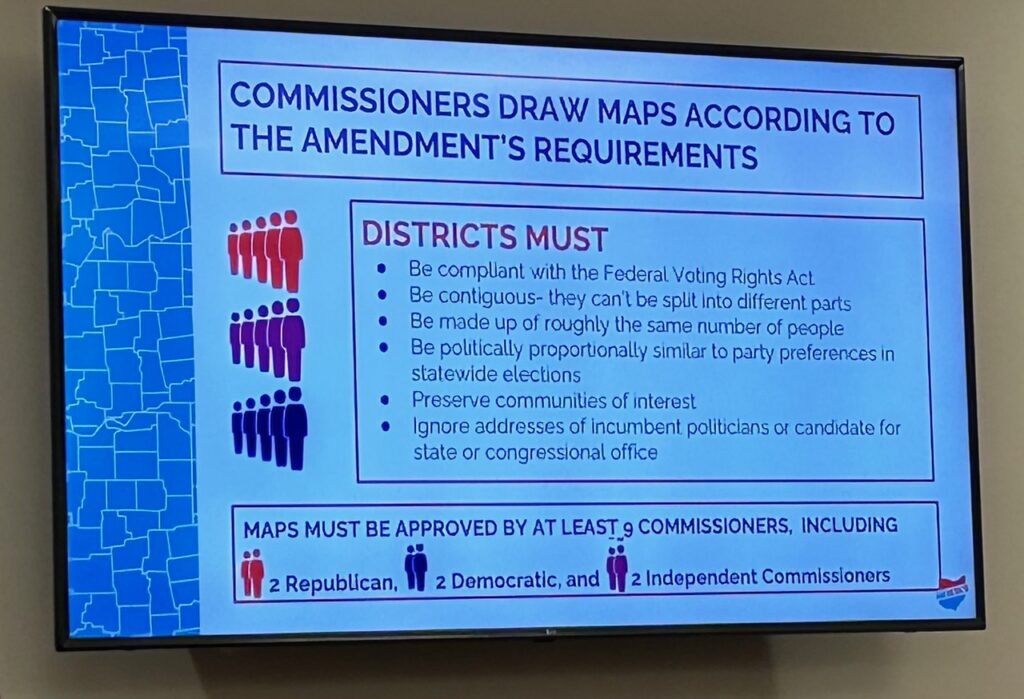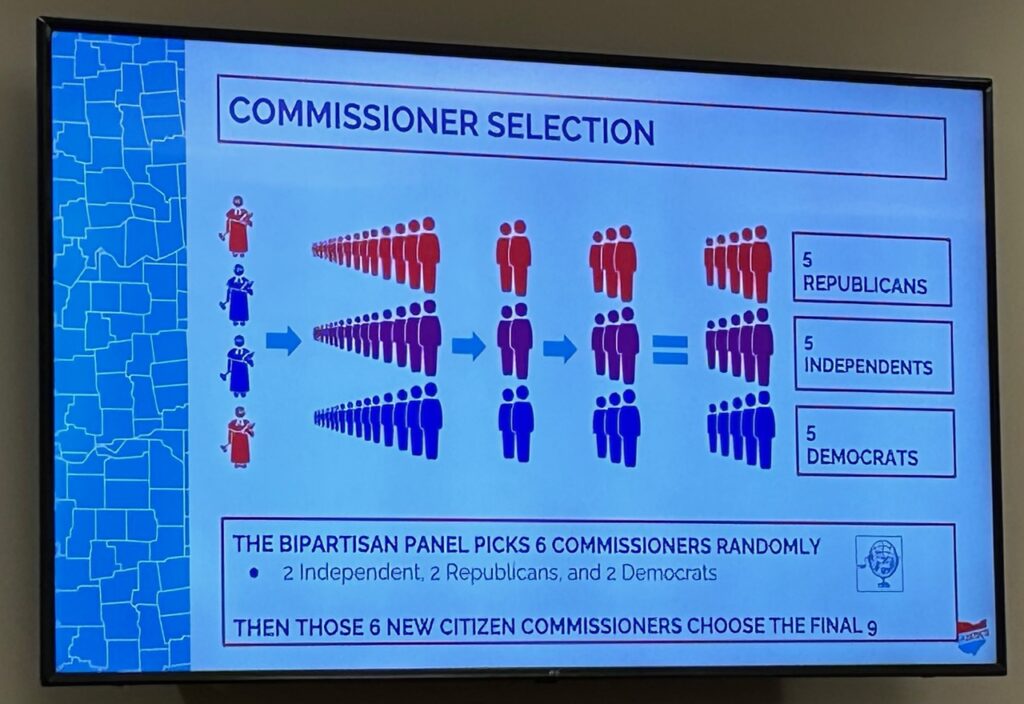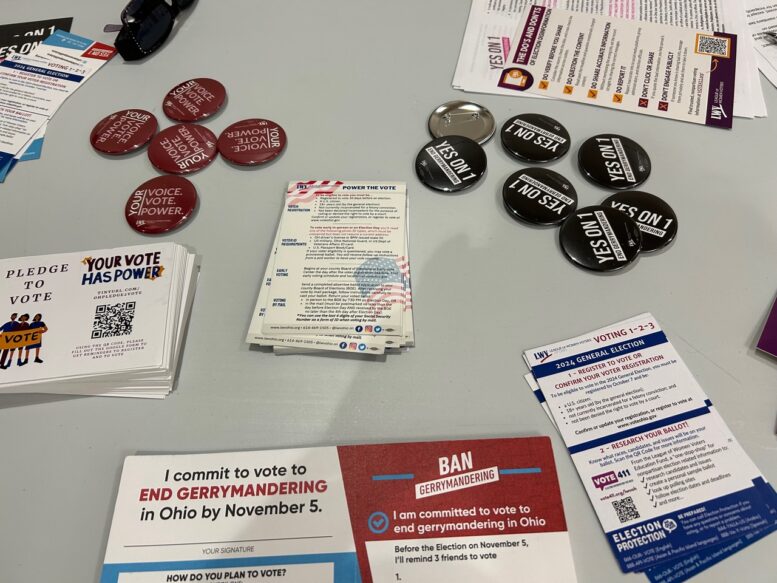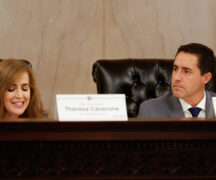By DAVID DUPONT
BG Independent News
Debbie Dalke established her credentials at the very beginning of informational session Monday on Issue 1, the proposed state constitutional amendment that would ban gerrymandering.
When she lived in California, a state dominated by Democrats, she voted against gerrymandering. Now in Ohio, formerly a swing state that’s increasingly dominated by Republicans, she one of the local leaders of the Citizens Not Politicians group behind Issue 1.
Both parties gerrymander, she said.

On election day Ohio voters will decide on Issue 1, the latest effort to end the packing and cracking of districts to favor the election outcomes for one party.
It’s a way, she said, for politicians to select their voters, rather than voters deciding who should serve in office.
This is the third time an anti-gerrymandering ballot measure has come before voters. The previous two won overwhelmingly. Still the effort to find a non-partisan way to draw districts for the state legislature and U.S. Congress stalled.
The most recent attempt approved by voters, ended up with seven new maps, each one thrown out by the Ohio Supreme Court. Maureen O’Connor, the chief justice at the time, was involved in crafting Issue 1.
Now Issue 1 would replace the current commission that draws the maps. The current commission is overwhelmingly Republican, consisting of seven members two appointed by the majority leaders of the State House and Senate, two appointed by the minority leaders, and the governor, auditor, and secretary of state. The three office holders are currently Republicans.
The amendment would have a 15-member commission, selected and appointed through a process involving retired judges. That commission would be split in equal parts Republicans, Democrats, and unaffiliated. It would exclude lobbyists and politicians
The argument against the current system is that it favors the majority party, Republicans. They get the majority of votes, close to 60 percent, in state elections, but supporters of Issue 1 argue gerrymandering results in disproportionate majorities in both the State Senate where they hold 79 percent of seats and House where they hold 68 percent of the seats— giving the GOP super majorities, large enough to override the governor’s vetoes.
But the members of those super majorities, noted Julie Claypool, who attended the session, were elected by voters. She wasn’t convinced the same wouldn’t occur under the new system.
She came away from the session frustrated. She wanted to hear both sides of the issue, but the session was devoted to putting forward a strong argument in favor of the amendment.Claypool said that some of what the group presented as “facts” were opinion.
Because of changes in campaign finance laws, the organizers, said they could not promote the event in advance, though they could invite the media to cover it.
Dalke and Shar Katzner opened the session with a primer on gerrymandering.
Using green and purple dots, they demonstrated fair districts which represent the disposition of partisans based on their share of the vote.
In packed districts, partisans are packed into district to create unbalanced representation. They also demonstrated what’s called cracked districts, a more elaborate system, which in the case demonstrated the creation of more districts that favored the minority party.

According to Citizens not Politicians, the amendment would:
- Create an independent, 15-member Ohio citizens redistricting commission.
- Ban current or former politicians, political party officials, and lobbyists from sitting on the commission.
- Require fair & impartial districts by making it unconstitutional to draw voting districts that discriminate against or favor any political party or individual politician.
- Require the commission to operate under an open and independent process.
To form that commission, the amendment calls for a complex process that starts with the four legislative members of the Ohio Ballot Board selecting retired judges. Those retired judges then selected a new group of retired judges.
Eventually these judges will solicit applications from those who want to serve on the redistricting commission. Of those applicants, 45 will be chosen as finalists, and six will be chosen randomly to fill the allotment of two Republicans, two Democrats, and two independents. (The amendment does not use party names, but refers to the as the first and second major parties.)

That group will then select nine more commissioners from the remaining 39 finalists. In the end the commission will have five members representing each party and independents as well as “the geographic and demographic diversity of Ohio.”
Party affiliation will be determined by participation in primary elections and other factors, including campaign donations.
The Ohio Republican Party, which opposed issue 1, has issued a video, that contends relying on using judges will not eliminate partisanship.
Retired judges are highly political, according to Alex Triantafilou, who served as a judge for about three and a half years and is now chairman of the Ohio Republican Party.
Supporters of Issue 1 argue that the ballot language does not accurately reflect the amendment and is slanted against it.
For example, Republican State Sen. Theresa Gavarone, amended the language that said the commission would be “required to gerrymander” districts.
Supporters challenged the ballot language, but the Ohio Supreme Court, made only minor changes.
Dalke also expressed concern about the number of pages a voter must scroll through to get to where they actually vote on the amendment. People need to be patient and go all the way down, she said.
She’s spoken to voters who aren’t sure they ended up voting on the measure. John Zanfardino, in the audience, reminded people that they can and should check their vote before casting in.





